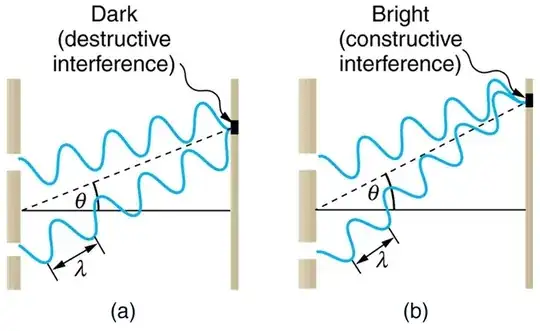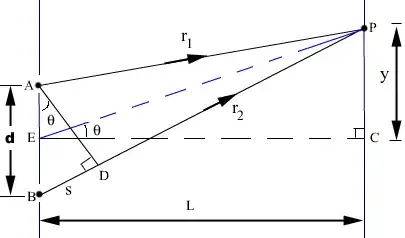I am studying high school physics and it seems i have memorize the equation and use it mechanically in doing question and memorize lots of physical phenomena.I know a lot of physical phenomena can be explained by Huygen principle (which i can't figure out the whys and do not understand).There are so many things I don't understand and get the intuition.I know high school math and basic calculus,but it seems it doesn't help to understand.I am frustrated.I do not want to go along with memorizing and pass the exam as i think it is meaningless.We are not machines.Are there any resources that can help?Are there any books better explain high school physics and explain theories using math?
2 Answers
sorry to hear that things are frustrating. I don't think you need the Huygen principle for the double slit experiment. Take a look at the diagram below...

The diagram shows two rays from a double slit experiment.
The path lengths are slightly different from the two slits.
In one case the waves arrive in phase and you get the bright fringe - constructive interference.
In the other the waves arrive out of phase and cancel out and you get the dark fringe - destructive interference.
Now look at the image below

The difference in the path lengths is $s$ and you should be able to see from geometry that $s = d sin \theta$. The for contstructive intereference $s$ is a whole number of wavelengths and for destructive interference it is a whole number plus a half....
I hope that helps to understand where the formula comes from for Young's slits and makes things seem a bit more logical. - do comment.
Note that generally $L$ is a very long distance compared to $y$ and $d$ so that makes the two angles $\theta$ are so close in value to each other that we can treat them as the same angle
For the most part, you are right. Physics is tough, and in many ways high school physics is the hardest because it is the first introduction to a new and difficult way of thinking. Furthermore, teachers are under pressure to complete the curriculum. And there's always the possibility that the teacher him/herself does not have a firm grasp of the subject.
It takes practice, and repetition, and struggle. Read the book chapter many times. Don't get stuck on a fine point that you don't understand: keep reading, and then read it again. And again. Work through the derivations in the book. Write the down in your own hand. Then do it again. You are training your synapses.
Fortunately, it's easy these days to get alternate presentations on the Internet, and you can ask questions on physics forums. There are several. But watch out: there are presentations out there that are just wrong, many of them written by high school teachers for high school students.
This is how everyone learns physics (unless you are Feynmann). Consider the typical educational path of a physics professional: you study mechanics in high school. You will again when you take Introductory Physics in college. Then again when you are a sophomore or junior when you take Classical Mechanics. Then Classical Mechanics again in graduate school. It's all about peeling the onion, one layer at a time, and that's what you have to do in high school. Read once. Read again. And again. Write the derivation once. Then again. And again. With each layer comes a little more understanding.
Formulas: I don't see much value in memorizing them. I believe that a teacher should allow a formula sheet. With time and usage, the important ones will stick, and you will need the formula sheet only for the less common ones. My memory is terrible. I would never make it as a biologist. But in physics, I don't have to memorize much.
Resource: get access to one of the good standard texts: Tipler, Halliday and Resnick, Knight, etc. Work through it and struggle.
- 22,633